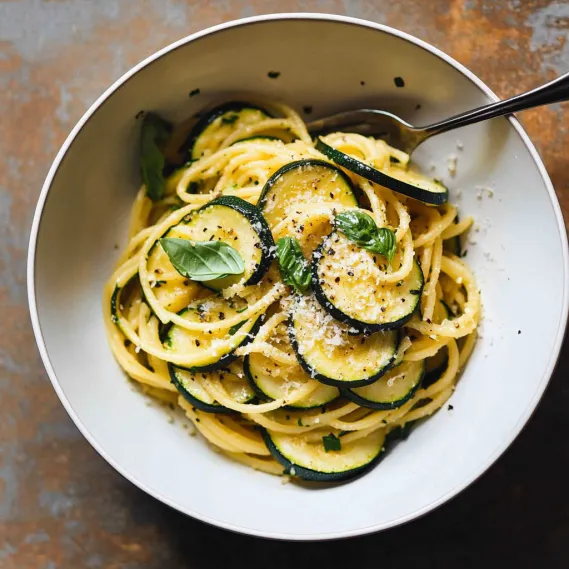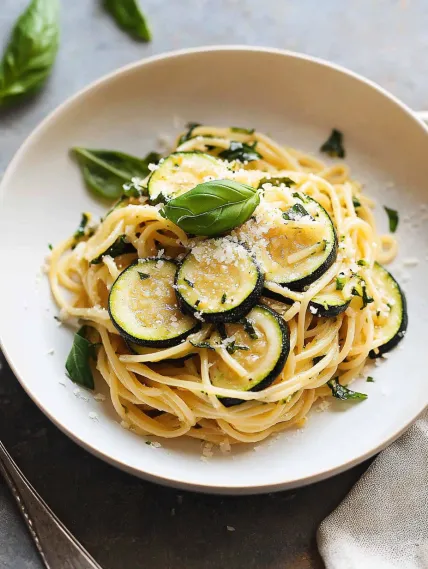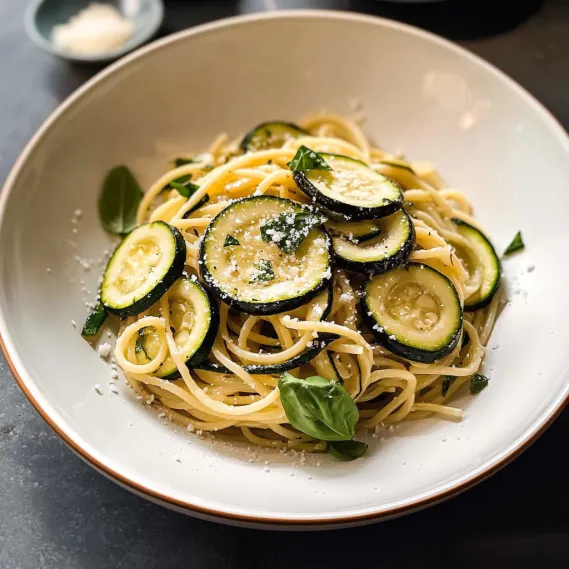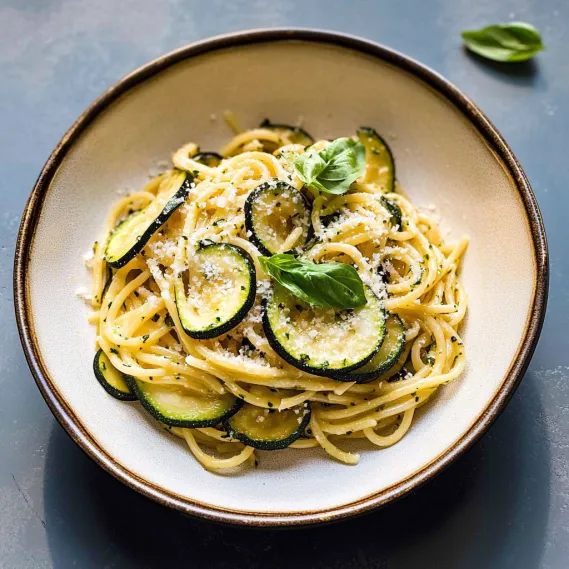 Pin it
Pin it
This Spaghetti alla Nerano transforms humble zucchini into a luxurious pasta experience that's simultaneously light and indulgent. The magic happens when thinly sliced zucchini is fried until golden, bringing out its natural sweetness and adding a nutty depth that ordinary zucchini dishes simply don't have. When tossed with perfectly al dente spaghetti, fresh basil, and aged cheese, it creates a velvety, flavor-packed sauce that clings to every strand. Made famous by Stanley Tucci's declaration that it's "one of the best things he's ever eaten," this dish proves that simplicity and technique can create something truly extraordinary.
I first attempted this recipe after watching Stanley Tucci rave about it on his show "Searching for Italy." Despite his enthusiastic endorsement, I was skeptical that zucchini could create something so magnificent. After my first bite, I understood his excitement completely. The sweetness of the fried zucchini combined with the salty cheese and aromatic basil creates something far greater than the sum of its parts. Now it's become my go-to dish when I want to transform simple ingredients into something truly special.
Essential Ingredients and Selection Tips
- Zucchini: Look for small, firm zucchini with deep green color. Smaller zucchini are sweeter, less watery, and contain fewer seeds than their larger counterparts.
- Sunflower Oil: With its high smoke point and neutral flavor, it's perfect for frying. Vegetable oil works well as a substitute.
- Parmesan Cheese: Freshly grated from a block yields the best texture and flavor. Traditionally made with provolone del Monaco, but Parmesan or caciocavallo make excellent substitutes.
- Fresh Basil: Essential for the authentic flavor profile. There's no substitute for fresh in this dish.
- Spaghetti: Use high-quality pasta that will maintain its al dente texture. The sauce clings best to long, thin pasta shapes.
The quality of your zucchini makes all the difference in this dish. I once made it with overgrown garden zucchini and was disappointed with the watery results. Small, firm zucchini create the perfect texture and concentrated flavor that makes this dish special.
Detailed Cooking Instructions
- Step 1: Perfect The Fried Zucchini
- Pour 2 cups of sunflower oil into a deep pot and heat to a gentle boil. Slice 5-6 small zucchini into thin rounds (about ⅛ inch thick) and fry in batches until golden brown and slightly crisp around the edges. Avoid overcrowding the pot, which prevents proper browning. Transfer to paper towels to drain excess oil.
- Step 2: Season While Hot
- Immediately transfer the warm fried zucchini to a bowl and toss with 10-12 fresh basil leaves torn into pieces, a pinch of kosher salt, and a drizzle of quality olive oil. This step infuses the zucchini with basil's aromatic oils while still warm. Let the mixture sit while you prepare the pasta.
- Step 3: Cook Pasta To Perfect Al Dente
- Bring a large pot of generously salted water to a rolling boil. Add 1 pound of spaghetti and cook until just al dente, about 1-2 minutes less than package directions. Before draining, reserve 2 cups of starchy pasta water - this is crucial for creating the creamy sauce. Drain pasta without rinsing.
- Step 4: Create The Silky Sauce
- In a large skillet over medium-low heat, combine the hot pasta with the fried zucchini mixture. Add about ½ cup of the reserved pasta water and toss continuously, allowing the starch and cheese to emulsify. If the mixture seems dry, add more pasta water a little at a time.
- Step 5: Finish With Cheese And Finesse
- Add 1 cup of freshly grated Parmesan cheese and continue tossing vigorously until the sauce becomes silky and coats each strand of pasta. The zucchini will begin to break down slightly, creating a creamy consistency. Finish with a drizzle of olive oil, a final sprinkle of cheese, and fresh basil leaves.
 Pin it
Pin it
The first time I made this dish, I nearly skipped the frying step, thinking I could get similar results by sautéing the zucchini. I'm so glad I didn't - that deep frying is transformative, creating a complexity of flavor that's impossible to achieve any other way. What begins as a humble vegetable becomes something so much more through this process.
The Secret to Perfect Texture
The most remarkable aspect of Spaghetti alla Nerano is its creamy texture, achieved without using any cream. Through extensive experimentation, I've discovered that success depends on three crucial factors. First, properly emulsifying the sauce by vigorously tossing the hot pasta with reserved pasta water and cheese creates that silky consistency. Second, the temperature matters tremendously - working with hot pasta in a warm (but not too hot) pan prevents the cheese from separating. Finally, the breakdown of the fried zucchini as you toss contributes to the sauce's body. My first few attempts resulted in clumpy cheese and separated sauce until I mastered the continuous tossing technique that chefs use, which makes all the difference.
 Pin it
Pin it
The History Behind the Dish
This pasta's fascinating origin story adds to its allure. Created in 1952 by restaurateur Maria Grazia in the small village of Nerano on Italy's Amalfi Coast, the original recipe remains a closely guarded secret. The restaurant still operates today, serving their famous zucchini pasta to tourists and locals alike. I've found that sharing this history while serving the dish adds to guests' appreciation - there's something special about connecting to a specific place and time through food. Learning that this humble pasta has been prepared essentially the same way for 70+ years gives it an authenticity that modern recipes often lack. Whenever I serve it, I like to mention Stanley Tucci's enthusiastic endorsement, which never fails to pique my guests' interest before they've taken their first bite.
Perfect Pairing Suggestions
The delicate yet rich flavors of Spaghetti alla Nerano call for thoughtful beverage pairings. I've found that crisp, mineral-forward Italian white wines like Vermentino or Pinot Grigio complement it beautifully, cutting through the richness while enhancing the zucchini's sweetness. For a non-alcoholic option, sparkling water with a squeeze of lemon brings refreshing contrast. To create a complete meal, I typically serve this pasta with a simple side salad dressed in lemon and olive oil - nothing that competes with the main attraction. For appetizers, avoid heavy or cheese-laden options that might overshadow the pasta. Instead, try something light like marinated olives or a small plate of prosciutto. The pasta itself is substantial enough that you don't need additional protein to create a satisfying meal.
Troubleshooting Common Challenges
After making this dish dozens of times, I've encountered and solved several common issues. If your sauce is too dry or the cheese is clumping, you probably need more pasta water - don't be shy about adding it generously. The starchy water is what creates that magical creaminess. If your zucchini disintegrated completely rather than maintaining some texture, you likely sliced it too thinly or overcooked it during frying. Aim for medium-thin slices (about ⅛ inch) and golden rather than deep brown coloring. Finally, if your finished dish lacks flavor despite following the recipe, the culprit is likely under-salted pasta water. Remember that properly salted pasta water (it should taste like seawater) is your first and most important seasoning opportunity.
 Pin it
Pin it
This Spaghetti alla Nerano has become my signature dish, the one friends request when they visit. What I love most is watching the expressions of pleasant surprise when people taste it for the first time - they never expect such deep, complex flavors from such simple ingredients. It's a reminder that cooking doesn't always require exotic components or complicated techniques to create something truly memorable - sometimes it's simply about treating humble ingredients with respect and understanding.
Frequently Asked Questions
- → Can I use a different type of pasta for this recipe?
- Yes, while traditional Spaghetti alla Nerano uses spaghetti, you can substitute other long pasta shapes like linguine, bucatini, or fettuccine. Short pasta shapes like penne or rigatoni will also work, though the texture and sauce-coating quality will be slightly different.
- → How thin should I slice the zucchini?
- Aim for slices about 1/8-inch (3mm) thick. You can use a sharp knife, but a mandoline slicer works best for consistent, thin slices. Thin slices will fry more evenly and integrate better into the final dish.
- → Can I make this dish healthier by using less oil?
- While traditional Spaghetti alla Nerano calls for frying the zucchini, you can reduce the oil by sautéing or even roasting the zucchini instead. The flavor will be different but still delicious. If sautéing, use about 3-4 tablespoons of oil and cook until tender with some golden spots. If roasting, toss with olive oil and bake at 425°F (220°C) for about 15-20 minutes.
- → What can I substitute for parmesan cheese?
- For a similar flavor profile, you can use Pecorino Romano, which is sharper but works well. Grana Padano is another excellent alternative that's slightly milder than parmesan. For a more authentic version of this dish, you could use Provolone del Monaco, which is traditionally used in the original recipe from Nerano, though it can be hard to find outside of Italy.
- → Why is my sauce not creamy enough?
- The creaminess comes from emulsifying the pasta water with the cheese. Make sure you've reserved enough starchy pasta water (at least 2 cups), add it gradually while the pasta is still hot, and keep tossing continuously. Also, finely grate your cheese - pre-grated cheese often contains anti-caking agents that can prevent it from melting smoothly.
- → Can I prepare any components of this dish ahead of time?
- Yes! The fried zucchini can be prepared up to 5 days ahead and stored in the refrigerator. When ready to use, bring it to room temperature before combining with the hot pasta. This makes meal prep much easier, as the most time-consuming part is already done.
